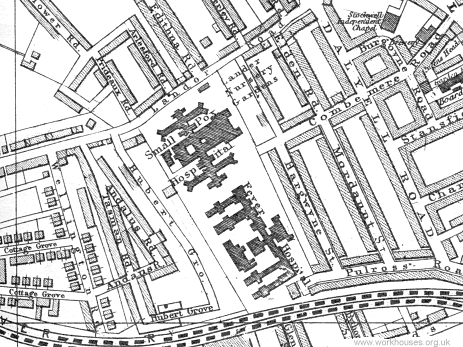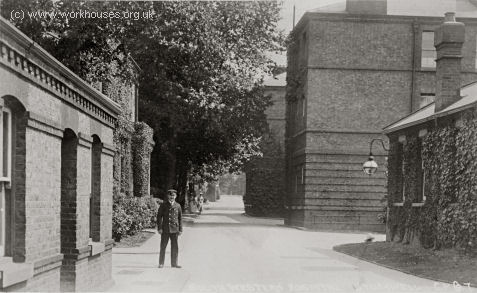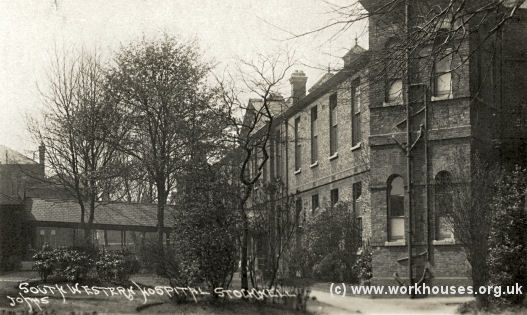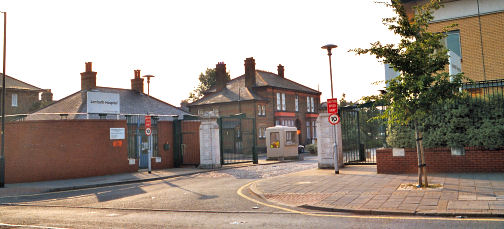The South Western Hospital, Stockwell
Stockwell was the location one of the earliest hospitals erected by the Metropolitan Asylums Board which had been set up in 1867 to administer care for certain categories of the sick poor in metropolitan London.
The Stockwell Hospital occupied a 7.5 acre site at the south of Landor Road, which had cost over £15,000 for the land alone. It opened on 31st January 1871, at the height of a smallpox epidemic in the capital. It would have been the MAB's first hospital but an outbreak of relapsing fever the previous year had forced the Board to erect temporary wards on a site at Hampstead.
Stockwell was actually two hospitals in one, with a 100-bed smallpox hospital designed by Thomas Henry Wyatt at the north of the site, and a 200-bed fever hospital designed by F Marrable at the south.
The site location and layout are shown on the 1888 map below.

South Western Hospital site, 1888.
On Feb 4th, 1871, The Builder reported that the hospital

South West Fever Hospital — Landor Road entrance from the north, c.1907.
© Peter Higginbotham

Smallpox ward block at South West Fever Hospital, early 1900s.
© Peter Higginbotham
From 1882, following pressure from local residents, and increasing evidence that smallpox was spread by direct contact with those already infected, hospitals such as Homerton and Stockwell restricted their smallpox admissions to cases living within a radius of one mile. The majority of smallpox patients were then treated on the MAB's hospital ships Atlas, Endymion and Castalia, moored on the Thames near Dartford. From around this time, the Stockewell Hospital was renamed the South Western Hospital.
In 1886, Stockwell was the subject of a scandal when Dr Wilson Pash, a former assistant medical officer at the hospital, published a number of serious complaints about medical practices employed there. These included
- a lack of medicine being administered to scarlet fever cases
- bedside medical record cards not being filled to record details of treatments administered by different staff
- a lack of basic equipment
- the inappropriate administration of castor oil to typhoid cases — a procedure which could seriously worsen their condition
Pash claimed that decisions about the administration of medical treatment had effectively been delegated to the head nurse who ruled the wards with a rod of iron. He also accused the Guardians of putting the saving of money before the interests of the patients.
In 1930, administration of the hospital passed to the London County Council. It then had 323 beds plus a nursery unit.
The old buildings were demolished when the hospital was rebuilt in the early 1990s. It reopened as the Lambeth and Maudsley NHS Trust and now bears the name Lambeth Hospital.

Lambeth Hospital from the north, 2004
© Peter Higginbotham
Staff
- (To be added)
Inmates
- (To be added)
Records
Note: many repositories impose a closure period of up to 100 years for records identifying individuals. Before travelling a long distance, always check that the records you want to consult will be available.
- London Metropolitan Archives, 40 Northampton Road, London EC1R OHB. Has virtually all the surviving records for the Metropolitan Asylums Board and its instititutions. Search their catalogue at https://search.lma.gov.uk/.
Bibliography
- Ayers, Gwendoline, M. (1971) England's First State Hospitals and the Metropolitan Asylums Board (Wellcome Institute of the History of Medicine, London).
- Powell, Sir Allan (1930) The Metropolitan Asylums Board and its Work, 1867-1930. (MAB, London)
Links
- None.
Unless otherwise indicated, this page () is copyright Peter Higginbotham. Contents may not be reproduced without permission.


